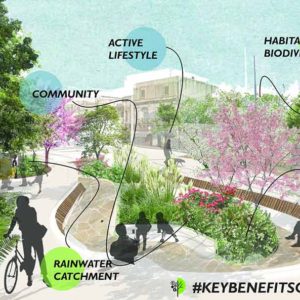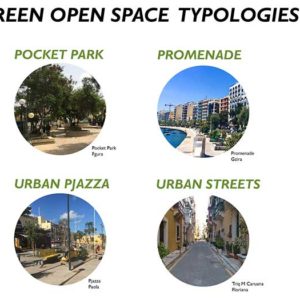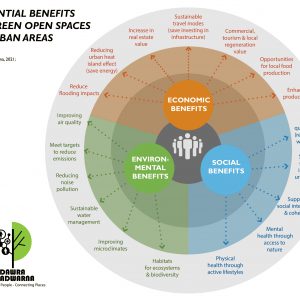Activities
The Importance of Green Open Space Networks in our Urban Environment
Author: Sarah Scheiber, May 2022
The need and importance of green recreational open spaces have recently been featured more frequently in the local agenda, in Malta. There seems to be greater demand and appreciation of the benefit of such spaces. Political commitments to the tune of a €700M investment package in green lungs within our urban areas has been made. The local narrative in acknowledging the importance and benefits of having green open spaces in urban areas has definitely come a long way from when I started my research on the quality of Malta’s urban open spaces back in 2013.
Fig 1: Illustrating some of the potential benefits of green open spaces in urban areas. Source: Katrina Grech Mallia, Conceptual Redesign of Pjazza tal-Ferrovija, Birkirkara
Just last year, Dawra Madwarna developed a position paper, based on local research, on the need for green open space networks in our dense urban areas and presented this to the relevant authorities and Ministries at the time. We are pleased to see that the narrative seems to be changing. We also feel it is important to break down further what we mean by green open space networks. What are some important considerations and principles when thinking about providing green recreational open spaces in our urban areas?
Fig 2: A potential classification of urban open space typologies for Malta. Source: Adapted from Scheiber, 2022
First of all, we need to talk about different types of spaces. Larger gardens or parks are important, green lungs are important, but so are the small incidental green pockets which people can enjoy when walking within their neighbourhoods. Similarly, small spaces where one can meet a friend for a chat, or have a quick lunch break are not commodities but essential needs. It is therefore important to understand which spaces exist within a community, which spaces are lacking, and the particular needs of such a community. We need to plan for different types of spaces which provide for different functions and which bring different demographics together as opposed to isolating them, as is often, for example, the case of children’s playgrounds isolated from other types of spaces or functions. Planning for a green open space network therefore means planning for different types of spaces, including streets.
And here is where another key principle comes in. A network is all about connectivity. How are these different spaces connected? Can we get to them, can they be accessed? Can we easily walk from one to the other such that active and healthy lifestyles are facilitated? Having a series of connected spaces, and being able to walk to such spaces is crucial in moving away from car dependence and promoting the use of sustainable transport modes such as walking, cycling or public transport. We therefore need to think not only of the individual, commonly thought of spaces such as parks, gardens or playgrounds, but also the streets which connect them. They are spaces in their own right which also have the potential to provide for social activities, thereby supporting social cohesion. This means being able to meet your neighbours and benefitting from knowing your local community. The planning and design of streets is crucial to creating a network which ensures that we can all easily reach the open spaces within our urban areas.
Fig 3: Principles for guiding the development of green open space networks.
There are other important principles, such as maximising the presence of vegetation which has the potential to provide multiple benefits. However, I would like to end this article by focusing on the principle of community engagement. How does one start to identify what the community needs? How does one identify the potential for open spaces and for moving towards providing such green open space networks? While the physical mapping of all existing open spaces is crucial, and while this can be done by planners or designers, one cannot undermine the importance of involving and speaking to the community to truly understand what they need, how they use the spaces, what the underlying potential is and what the challenges which will need to be overcome are.
So, while the idea of green open spaces networks requires a strategic and integrated planning approach, it also requires a participatory one. In fact, these are two of the key elements included in the approach for moving towards green open space networks discussed in our position paper. If you would like to read more about this you can find the full version published here: https://issuu.com/dawramadwarna/docs/ma-dwarna_proposal_final
Fig 4. Visioning greener cities and towns Source: Dawra Madwarna





